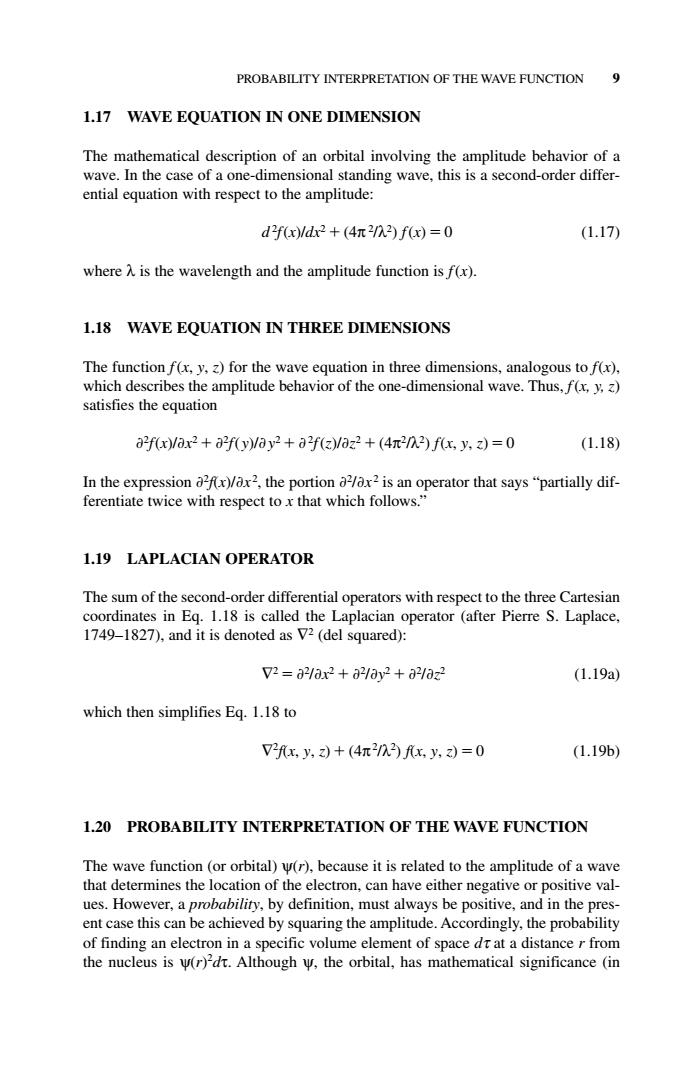正在加载图片...

PROBABILITY INTERPRETATION OF THE WAVE FUNCTION 9 1.17 WAVE EQUATION IN ONE DIMENSION The mathematical description of an orbital involving the amplitude behavior of a wave.In the case of a one-dimensional standing wave,this is a second-order differ- ential equation with respect to the amplitude: dfx)/dx2+(4π23fx)=0 (1.17) whereis the wavelength and the amplitude function isf(). 1.18 WAVE EQUATION IN THREE DIMENSIONS The function f(x,y.z)for the wave equation in three dimensions,analogous to f(x). which describes the amplitude behavior of the one-dimensional wave.Thus,f(x,y.z) satisfies the equation af(x)/ax2+af(y)/ay2+af(z)/az2+()f(x.y.z)=0 (1.18) In the portion aaxis an operator that says"partially dif- ferentiate twice with respect to x that which follows. 1.19 LAPLACIAN OPERATOR ect to the three Cartesian es in Eq. 1.18is called the operator (after Pierre S.Laplace 2(del squared) V2 =a21ax2+a2/ay2+a21a2 (1.19a) which then simplifies Eq.1.18 to xy,)+(4π2n3fxy,)=0 (1.19b) 1.20 PROBABILITY INTERPRETATION OF THE WAVE FUNCTION The wave function (or orbital)(r).because it is related to the amplitude of a wave that determines the location of the electron,can have either negative or positive val- ues.However,a probability,by definition,must always be positive,and in the pres ent case this can be achieved by qangeaplmdcAceoiney,thePoab西 electro in a speci ele ent of sp ce dr nce r from nucleus is r)dt.Although the orbital,has mathematical significance (in1.17 WAVE EQUATION IN ONE DIMENSION The mathematical description of an orbital involving the amplitude behavior of a wave. In the case of a one-dimensional standing wave, this is a second-order differential equation with respect to the amplitude: d 2 f(x)/dx2 (4π 2 /λ2 ) f(x) 0 (1.17) where λ is the wavelength and the amplitude function is f(x). 1.18 WAVE EQUATION IN THREE DIMENSIONS The function f(x, y, z) for the wave equation in three dimensions, analogous to f(x), which describes the amplitude behavior of the one-dimensional wave. Thus, f(x, y, z) satisfies the equation 2 f(x)/x2 2 f(y)/y2 2 f(z)/z2 (4π2 /λ2 ) f(x, y, z) 0 (1.18) In the expression 2 f(x)/x 2 , the portion 2 /x 2 is an operator that says “partially differentiate twice with respect to x that which follows.” 1.19 LAPLACIAN OPERATOR The sum of the second-order differential operators with respect to the three Cartesian coordinates in Eq. 1.18 is called the Laplacian operator (after Pierre S. Laplace, 1749–1827), and it is denoted as ∇2 (del squared): ∇2 2 /x2 2 /y2 2 /z2 (1.19a) which then simplifies Eq. 1.18 to ∇2 f(x, y, z) (4π2 /λ2 ) f(x, y, z) 0 (1.19b) 1.20 PROBABILITY INTERPRETATION OF THE WAVE FUNCTION The wave function (or orbital) ψ(r), because it is related to the amplitude of a wave that determines the location of the electron, can have either negative or positive values. However, a probability, by definition, must always be positive, and in the present case this can be achieved by squaring the amplitude. Accordingly, the probability of finding an electron in a specific volume element of space dτ at a distance r from the nucleus is ψ(r)2 dτ. Although ψ, the orbital, has mathematical significance (in PROBABILITY INTERPRETATION OF THE WAVE FUNCTION 9 c01.qxd 5/17/2005 5:12 PM Page 9